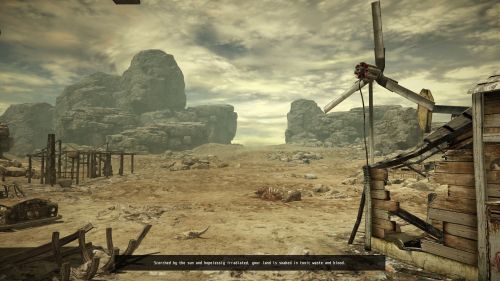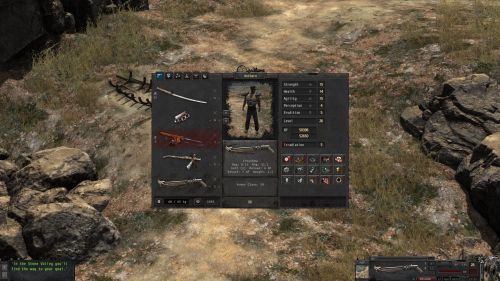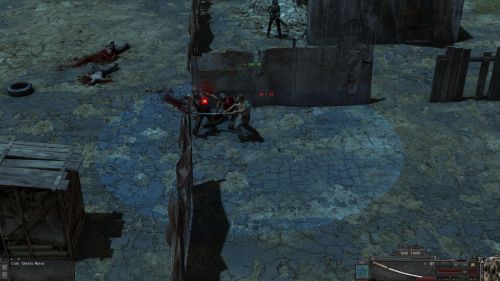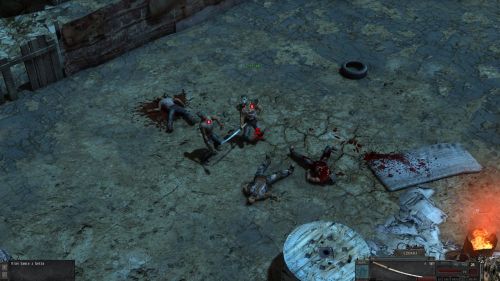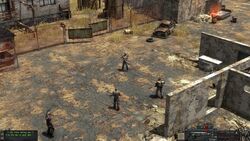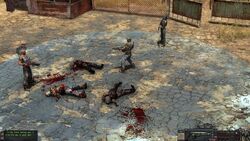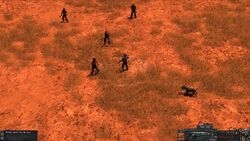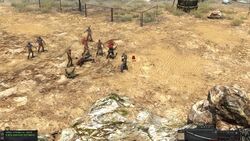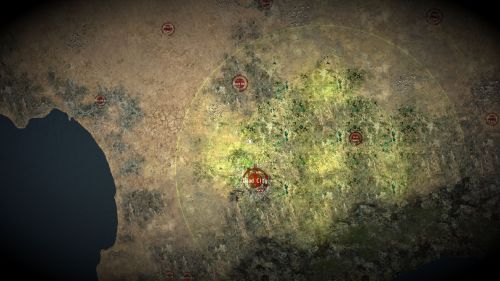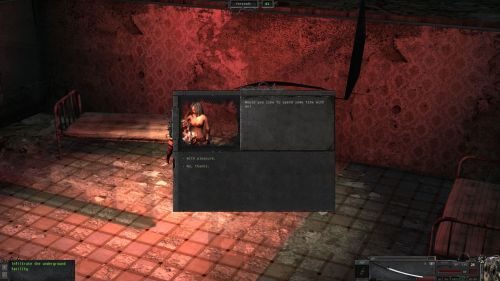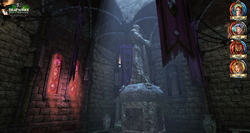RPG Codex Review: Krai Mira
RPG Codex Review: Krai Mira
Codex Review - posted by Infinitron on Mon 5 October 2020, 22:30:41
Tags: Krai Mira; Tall Tech Studio[Review by Lord_Potato]
Imagine if someone played Fallout and decided that the best qualities of that masterpiece were its tactical turn-based combat and a non-interactive version of its main story. Now imagine this person making a post-apocalyptic tribute to Fallout based mostly on just those two qualities. That’s how you get Krai Mira. A combat-heavy RPG that trades Fallout's freedom for a linear adventure in a world that pretends to be open, but really isn't.
I decided to give Krai Mira a try for two reasons. First, because I'm a sucker for post-apocalyptic RPGs. Interplay and Obsidian's Fallouts, Underrail, and ATOM are among my favorite titles, and I've also enjoyed Fallout 2 total conversions such as Resurrection and Nevada. Second, because I like to explore obscure RPGs and search for the true pearls of the genre. Sometimes it works and I have a great time with titles such as Prelude to Darkness or Teudogar and the Alliance with Rome. Other times it doesn't, and then I have to soldier through the likes of Another War, Gorasul: Legacy of the Dragon or Heath: the Unchosen Path. The life of an explorer is not always a bed of roses. Sometimes you have to suffer the thorns.
So before the releases of Trudograd and Encased, which will probably happen next year, I wanted to check out some the post-apocalyptic genre's older titles, like Last Days of Gaia and Krai Mira. Here I will focus on the second game, which I managed to complete a few days ago.
The story of Krai Mira plays out on the ravaged peninsula of Crimea. Due to rising sea levels and an apocalyptic event known as the Bang, Crimea became an island totally separated from the continent. The year is 2032 and humanity has regressed into a premodern state while managing to preserve some of the technological advances of the 21st century. Crimea is divided among several factions: the Empire that controls most of the island and wages war on all fronts, the barbaric and allegedly cannibalistic Taurs, the free merchant town of Kafa (ancient Kaffa/Theodosia, now mostly swallowed by the rising sea), and a group of former outlaws who settled in an old tanker terminal and make a living selling fuel to everyone else. There are also various minor outlaw clans, intelligent and feral mutants, wandering merchants, and several settlements that are not strong enough to be considered full-fledged factions.
It all sounds pretty cool, but unfortunately the holes in world-building quickly become apparent. Twenty years is too short a period of time for humans to return to tribal ways, and many characters you meet in the game still remember the times before the "Bang." This was no nuclear war. The Bang was simply the explosion of one of the nuclear reactors situated in Crimea (fun fact: in reality, there are no nuclear reactors in Crimea. The only Soviet power plant that was constructed on the peninsula was abandoned after the Chernobyl catastrophe). Judging from the enormous patch of irradiated wasteland in the center of the island, the calamity happened in or near Simferopol, which is now known as the "Dead City” and is one of the more hostile locations in the game. But what happened to the rest of the world? The people of Crimea seem to be oblivious to the existence of anything beyond the island. No one comes to Crimea from abroad. No one tries to leave the war-torn island to search for a more peaceful life elsewhere. It's all shallow, juvenile and presented in a poor manner. Until several hours into the game, I didn't even know about the existence of the Empire, the heaviest hitter in the setting. Somehow the game managed to avoid providing this crucial piece of information. This might be acceptable in Fallout, where the player character comes from a vault and has no prior knowledge of the surrounding world. However, in Krai Mira the PC is a citizen of a village located within imperial territory. He should have at least some rudimentary awareness of the political balance of power on the island.
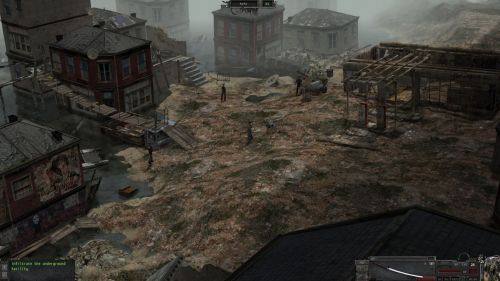
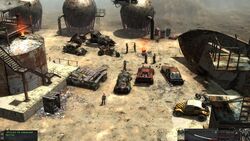

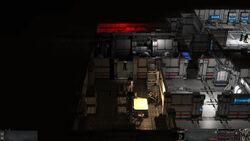
The game provides many diverse environments to explore. Too bad there are so few interesting things to discover
The game begins with a short intro cutscene, but there is no character creation sequence as such. Our PC starts out simply standing on a beach. We can name him, distribute several points between five main stats, and invest two points into one of three available perks. The stats are strength, health, agility, perception, and "erudition", which is basically intellect and charisma combined. Throughout the game the PC will gain access to fifteen perks, which are mostly focused on stealth and melee combat. Each perk has three levels of advancement. There are no skills in the game and hence no skill checks. Stat checks in dialogue are very rare. Sometimes high erudition provides you with an additional dialogue choice or allows you to talk someone into helping you without material gratification. But that is all you will get out of making your guy a smooth talker. Upon gaining a new level you get one stat point and one perk point, which you may invest as you see fit.
Unfortunately, the system is very basic and unbalanced. There’s only one way to build your character well. On my first try, I created the character I usually play in Fallout games: an eloquent gunslinger (high perception, agility, erudition). Soon I learned that such a build is simply unfeasible in Krai Mira. Erudition provides too few opportunities to justify the stat investment. And as for perception, while the game offers a wide selection of guns, rifles, crossbows, and flamethrowers that use five different types of ammo, it provides far too few bullets. A gunslinger cannot allow himself the luxury of a weapon of choice. He has to hold on to any ammunition he can find and carry several guns in order not to be caught with an empty barrel. Unfortunately, in order to carry those guns or operate heavier weapons, he needs high strength. And in order to deal with the game’s hordes of melee enemies, he needs high agility to get more action points during his turns, so that he can shoot and then flee to safety. High health, required to wear better armor, becomes an unobtainable luxury as you'd have to spread your precious stat points too thinly. After several hours of this, I abandoned my eloquent gunslinger and restarted. Playing such a character was just too tedious and unfun.
The one and only feasible build is a melee tank, which is also reinforced by the majority of available perks. You put points into strength, health, and agility and keep on doing it until they all reach 13-15 points (which is about when the game will end). This will allow the PC to wear the best armor and carry the best melee and projectile weapons, with tons of health points and a decent damage reduction. Of course, due perception being a dump stat he can only shoot the automatic rifle at point-blank range, but at least he can do it. A point-starved gunslinger would never be able to reach the strength value of 13 needed for such a feat. The melee tank mostly fights on the front lines, which is good since the few party members you meet in the game are extremely stupid and die easily. So you need to position your PC in front of these idiots so that the enemies hit him instead.
That said, the combat actually feels pretty solid. With only one feasible build, it's a simple matter of smacking enemies with the biggest club or blade you can find. Guns sometimes offer several fire modes and bursts can hit multiple foes, but you need to conserve ammo so going in guns blazing is rarely a good tactical choice. In true Fallout tradition you can only control the PC while your party members fight on their own, governed by the AI. When human allies are present on the battlefield you ought to take care to strike the killing blow against your foes, otherwise you won't receive experience points. There is an exception to this rule, though. Enemies killed by your most loyal follower, the dog Rudi, do grant you experience.
The enemy AI is simplistic but aggressive, and may pose a challenge through sheer brutality. Hostile combatants try to swarm you with their usually superior numbers and melee fighters do their best to protect the shooters. They attack with truly suicidal determination and retreat only when left with a couple of health points and no medical supplies. Since there are no grenades, the only effective method of crowd control is through the generous use of traps. But since traps pose a serious threat to your allies as well, it's best to avoid them if you're not fighting on your own.
Apart from that, most tactics revolve around choosing when to inject stimpacks and drugs into your PC's system. And of course, selecting your targets is also important. You should always go for the shooters first, even if it exposes you to numerous melee attacks on the way. Despite the system's simplicity, dispatching enemies with a large hammer, a chainsaw, or a katana is very gratifying (and gory). Even better, all the enemies move at the same time during their turn, so you don't have to wait for long minutes as in Fallout. While there is plenty of combat, it does not waste your time, which is a good thing.
Combat difficulty changes significantly over the course of the campaign. At the beginning, it’s similar to Piranha Bytes' Gothic series. You often have to rely on allies and in their absence may be forced to flee from the battlefield, as any confrontation can prove lethal for an ill-equipped and inexperienced PC. After you’ve gained some levels and acquired better gear, your situation improves drastically and fighting even large groups of foes becomes feasible. However, during the endgame you start encountering squads of heavily armed elite soldiers, and their machine gun bursts can quickly eat through hundreds of health points. At this point in the game you have to pick your battles, mind your positioning, and use every natural barrier to protect yourself from enemy fire. This evolution, combined with an acceptable level of enemy variety, helps keep things fresh.
There are only a few followers in Krai Mira. There are three in the introduction, but you quickly lose them, after which you meet Rudi the dog. Other characters (never more than one or two) may join the party from time to time and leave it as the story demands. They have very little personality outside their initial dialogues and you won't be forging memorable friendships. While you can give them simple commands (stay close or far, use the best weapon, etc), you don't have access to their inventories and unfortunately can't make them your pack mules. That makes the strength of your PC even more important, once again pushing him into the role of melee combatant.
During your travels through Crimea you will find a wide variety of loot. There’s a wide selection of melee and projectile weapons, lots of armor types, traps, ammunition, drugs, and some nice unique objects. Unfortunately, at certain points during the story the PC will be stripped of all his gear, with no possibility of getting it back. I hate when games do that and in Krai Mira it happens not once, not twice, but three times. It's true that you’ll soon obtain equipment of similar quality since every nook and cranny of the wasteland seems to be filled with useful items, but one time I lost a unique katana and was truly infuriated.
Krai Mira’s visuals and music are surprisingly good, taking into consideration the limited scale and budget of the project. The graphics may not be next-gen but are totally acceptable for a post-apocalyptic isometric game. I would rate it slightly below ATOM. Some locations, especially forests and mountain regions, actually look quite good, while decrepit towns and desolate pre-cataclysm structures are believable and authentic. However, water proves to be a problem for the engine and textures sometimes glitch out. Characters are not very detailed, but you usually observe them from a distance, so it’s not a big deal. Thankfully the camera can be zoomed out quite far, giving you a good tactical view of your location. The various weapons and armor equipped by the PC are visible on his person. I really enjoy the visual effects of radiation and drugs. The colors of the surrounding environment become unreal and the contours of buildings and characters start to dance before your eyes. It's crazy and fun. The soundtrack only has a few tunes, but they are quite pleasurable to listen to. Some of the tracks are slightly reminiscent of Arcanum, others of Fallout, and some even sound like Disco Elysium. Somehow they fit the bleak atmosphere and I did not feel the need to turn the music off until the very end.
Another nice element of Krai Mira is the global map. It's clear and helpful, filled with locations to visit, with a day and night cycle and pleasant music. It encourages exploration. Too bad most of these locations are pretty boring and there's not much to do in them. While you can trade with almost every non-plot critical NPC, most of them only have a few screws (the currency of this world) or bullets. In each location there are usually two or three wealthier traders with whom you can strike a bigger deal. There are also one or two plot critical characters with whom you have to speak to move the story forward.
Sometimes you will encounter caravan merchants. While they have surprisingly few items to trade, they do provide job opportunities in the protection business. Protecting caravans (which usually means going through four to six battles during a single run) is a good way to grind for experience and items. Another repeatable activity is treasure hunting. When your PC hires a prostitute (who are common in major settlements) she will occasionally give him a tip about a stash hidden by one of her other clients. This happens regularly and makes me wonder why would anyone be so open about his belongings in the company of these notoriously indiscrete sex workers. What’s even more strange is that you don't have to pay anything for this piece of intel.
Unfortunately, these are the only side activities in Krai Mira. Let me repeat: There are no proper side quests in this game that strives to be a successor to Fallout. All quests are part of the main plot and you solve them one after the other in a strictly linear order. While you can go anywhere on the map whenever you want, you'll often find that locations are empty since the plot hasn’t put any proper NPCs there yet. The story does not offer even an ounce of freedom. You very rarely have any choice in how to solve quests, and even when you do, your choice is inconsequential to how events unfold.
The story itself is not bad, but the suboptimal translation sometimes makes it difficult to understand what's happening and why. It begins on a beach on the northern shore of Crimea, where the PC hears news of impending doom. A barbarian cannibal tribe is approaching his home village of Quiet Bay. He encounters a unit of soldiers, who he only later learns are members of the imperial military. They are unable to organize an effective defense and the population of the village is evacuated to a safer region, while our PC together with his three colleagues travels to the nearby fort to join the army. Once there, he quickly learns that not everything he believes is true. Our PC is soon sucked into a brutal plot of subterfuge, betrayal, and power struggles on both local and global levels. The authors tried to explore various themes: the use of fake news and false flag attacks to fortify support for an oppressive regime, the convoluted power structure of a dictatorship, the very meaning of truth in a world where everyone lies. However, the result is quite underwhelming and the story never really leads anywhere. It fails to provide answers to many of the questions it tries to pose. The ending is an unsatisfying mess, with a villain who comes out of nowhere and a final choice that proves to be completely meaningless and emotionally empty.
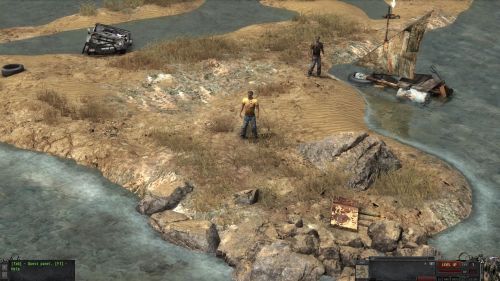
Our PC starts his adventure on a beach. The character models are not very detailed, but usually you see them from a greater distance
It’s clear to me that Krai Mira was created by a team of people who sincerely loved Fallout but did not really understand it. They did not grasp that the main strength of that masterpiece was the freedom and reactivity it offered. Strip away that freedom and reactivity and you get a linear, repetitive game. At the end of the day, despite its decent presentation and enjoyable combat, Krai Mira fails on too many levels. The game just has too little worldbuilding, character building, story, side quests, and agency. It does not receive my recommendation.
The good thing about Krai Mira is that it won’t waste much of your time. The campaign can be finished in about eighteen hours, maybe one or two more if you grind the caravans a lot. Try it out only if you are starved for a post-apocalyptic RPG and have already played the hell out of every Fallout, ATOM, and Underrail you could get hold of.
Imagine if someone played Fallout and decided that the best qualities of that masterpiece were its tactical turn-based combat and a non-interactive version of its main story. Now imagine this person making a post-apocalyptic tribute to Fallout based mostly on just those two qualities. That’s how you get Krai Mira. A combat-heavy RPG that trades Fallout's freedom for a linear adventure in a world that pretends to be open, but really isn't.
I decided to give Krai Mira a try for two reasons. First, because I'm a sucker for post-apocalyptic RPGs. Interplay and Obsidian's Fallouts, Underrail, and ATOM are among my favorite titles, and I've also enjoyed Fallout 2 total conversions such as Resurrection and Nevada. Second, because I like to explore obscure RPGs and search for the true pearls of the genre. Sometimes it works and I have a great time with titles such as Prelude to Darkness or Teudogar and the Alliance with Rome. Other times it doesn't, and then I have to soldier through the likes of Another War, Gorasul: Legacy of the Dragon or Heath: the Unchosen Path. The life of an explorer is not always a bed of roses. Sometimes you have to suffer the thorns.
So before the releases of Trudograd and Encased, which will probably happen next year, I wanted to check out some the post-apocalyptic genre's older titles, like Last Days of Gaia and Krai Mira. Here I will focus on the second game, which I managed to complete a few days ago.
The story of Krai Mira plays out on the ravaged peninsula of Crimea. Due to rising sea levels and an apocalyptic event known as the Bang, Crimea became an island totally separated from the continent. The year is 2032 and humanity has regressed into a premodern state while managing to preserve some of the technological advances of the 21st century. Crimea is divided among several factions: the Empire that controls most of the island and wages war on all fronts, the barbaric and allegedly cannibalistic Taurs, the free merchant town of Kafa (ancient Kaffa/Theodosia, now mostly swallowed by the rising sea), and a group of former outlaws who settled in an old tanker terminal and make a living selling fuel to everyone else. There are also various minor outlaw clans, intelligent and feral mutants, wandering merchants, and several settlements that are not strong enough to be considered full-fledged factions.
It all sounds pretty cool, but unfortunately the holes in world-building quickly become apparent. Twenty years is too short a period of time for humans to return to tribal ways, and many characters you meet in the game still remember the times before the "Bang." This was no nuclear war. The Bang was simply the explosion of one of the nuclear reactors situated in Crimea (fun fact: in reality, there are no nuclear reactors in Crimea. The only Soviet power plant that was constructed on the peninsula was abandoned after the Chernobyl catastrophe). Judging from the enormous patch of irradiated wasteland in the center of the island, the calamity happened in or near Simferopol, which is now known as the "Dead City” and is one of the more hostile locations in the game. But what happened to the rest of the world? The people of Crimea seem to be oblivious to the existence of anything beyond the island. No one comes to Crimea from abroad. No one tries to leave the war-torn island to search for a more peaceful life elsewhere. It's all shallow, juvenile and presented in a poor manner. Until several hours into the game, I didn't even know about the existence of the Empire, the heaviest hitter in the setting. Somehow the game managed to avoid providing this crucial piece of information. This might be acceptable in Fallout, where the player character comes from a vault and has no prior knowledge of the surrounding world. However, in Krai Mira the PC is a citizen of a village located within imperial territory. He should have at least some rudimentary awareness of the political balance of power on the island.




The game provides many diverse environments to explore. Too bad there are so few interesting things to discover
The game begins with a short intro cutscene, but there is no character creation sequence as such. Our PC starts out simply standing on a beach. We can name him, distribute several points between five main stats, and invest two points into one of three available perks. The stats are strength, health, agility, perception, and "erudition", which is basically intellect and charisma combined. Throughout the game the PC will gain access to fifteen perks, which are mostly focused on stealth and melee combat. Each perk has three levels of advancement. There are no skills in the game and hence no skill checks. Stat checks in dialogue are very rare. Sometimes high erudition provides you with an additional dialogue choice or allows you to talk someone into helping you without material gratification. But that is all you will get out of making your guy a smooth talker. Upon gaining a new level you get one stat point and one perk point, which you may invest as you see fit.
Unfortunately, the system is very basic and unbalanced. There’s only one way to build your character well. On my first try, I created the character I usually play in Fallout games: an eloquent gunslinger (high perception, agility, erudition). Soon I learned that such a build is simply unfeasible in Krai Mira. Erudition provides too few opportunities to justify the stat investment. And as for perception, while the game offers a wide selection of guns, rifles, crossbows, and flamethrowers that use five different types of ammo, it provides far too few bullets. A gunslinger cannot allow himself the luxury of a weapon of choice. He has to hold on to any ammunition he can find and carry several guns in order not to be caught with an empty barrel. Unfortunately, in order to carry those guns or operate heavier weapons, he needs high strength. And in order to deal with the game’s hordes of melee enemies, he needs high agility to get more action points during his turns, so that he can shoot and then flee to safety. High health, required to wear better armor, becomes an unobtainable luxury as you'd have to spread your precious stat points too thinly. After several hours of this, I abandoned my eloquent gunslinger and restarted. Playing such a character was just too tedious and unfun.
The one and only feasible build is a melee tank, which is also reinforced by the majority of available perks. You put points into strength, health, and agility and keep on doing it until they all reach 13-15 points (which is about when the game will end). This will allow the PC to wear the best armor and carry the best melee and projectile weapons, with tons of health points and a decent damage reduction. Of course, due perception being a dump stat he can only shoot the automatic rifle at point-blank range, but at least he can do it. A point-starved gunslinger would never be able to reach the strength value of 13 needed for such a feat. The melee tank mostly fights on the front lines, which is good since the few party members you meet in the game are extremely stupid and die easily. So you need to position your PC in front of these idiots so that the enemies hit him instead.
That said, the combat actually feels pretty solid. With only one feasible build, it's a simple matter of smacking enemies with the biggest club or blade you can find. Guns sometimes offer several fire modes and bursts can hit multiple foes, but you need to conserve ammo so going in guns blazing is rarely a good tactical choice. In true Fallout tradition you can only control the PC while your party members fight on their own, governed by the AI. When human allies are present on the battlefield you ought to take care to strike the killing blow against your foes, otherwise you won't receive experience points. There is an exception to this rule, though. Enemies killed by your most loyal follower, the dog Rudi, do grant you experience.
The enemy AI is simplistic but aggressive, and may pose a challenge through sheer brutality. Hostile combatants try to swarm you with their usually superior numbers and melee fighters do their best to protect the shooters. They attack with truly suicidal determination and retreat only when left with a couple of health points and no medical supplies. Since there are no grenades, the only effective method of crowd control is through the generous use of traps. But since traps pose a serious threat to your allies as well, it's best to avoid them if you're not fighting on your own.
Apart from that, most tactics revolve around choosing when to inject stimpacks and drugs into your PC's system. And of course, selecting your targets is also important. You should always go for the shooters first, even if it exposes you to numerous melee attacks on the way. Despite the system's simplicity, dispatching enemies with a large hammer, a chainsaw, or a katana is very gratifying (and gory). Even better, all the enemies move at the same time during their turn, so you don't have to wait for long minutes as in Fallout. While there is plenty of combat, it does not waste your time, which is a good thing.
Combat difficulty changes significantly over the course of the campaign. At the beginning, it’s similar to Piranha Bytes' Gothic series. You often have to rely on allies and in their absence may be forced to flee from the battlefield, as any confrontation can prove lethal for an ill-equipped and inexperienced PC. After you’ve gained some levels and acquired better gear, your situation improves drastically and fighting even large groups of foes becomes feasible. However, during the endgame you start encountering squads of heavily armed elite soldiers, and their machine gun bursts can quickly eat through hundreds of health points. At this point in the game you have to pick your battles, mind your positioning, and use every natural barrier to protect yourself from enemy fire. This evolution, combined with an acceptable level of enemy variety, helps keep things fresh.
There are only a few followers in Krai Mira. There are three in the introduction, but you quickly lose them, after which you meet Rudi the dog. Other characters (never more than one or two) may join the party from time to time and leave it as the story demands. They have very little personality outside their initial dialogues and you won't be forging memorable friendships. While you can give them simple commands (stay close or far, use the best weapon, etc), you don't have access to their inventories and unfortunately can't make them your pack mules. That makes the strength of your PC even more important, once again pushing him into the role of melee combatant.
During your travels through Crimea you will find a wide variety of loot. There’s a wide selection of melee and projectile weapons, lots of armor types, traps, ammunition, drugs, and some nice unique objects. Unfortunately, at certain points during the story the PC will be stripped of all his gear, with no possibility of getting it back. I hate when games do that and in Krai Mira it happens not once, not twice, but three times. It's true that you’ll soon obtain equipment of similar quality since every nook and cranny of the wasteland seems to be filled with useful items, but one time I lost a unique katana and was truly infuriated.
Krai Mira’s visuals and music are surprisingly good, taking into consideration the limited scale and budget of the project. The graphics may not be next-gen but are totally acceptable for a post-apocalyptic isometric game. I would rate it slightly below ATOM. Some locations, especially forests and mountain regions, actually look quite good, while decrepit towns and desolate pre-cataclysm structures are believable and authentic. However, water proves to be a problem for the engine and textures sometimes glitch out. Characters are not very detailed, but you usually observe them from a distance, so it’s not a big deal. Thankfully the camera can be zoomed out quite far, giving you a good tactical view of your location. The various weapons and armor equipped by the PC are visible on his person. I really enjoy the visual effects of radiation and drugs. The colors of the surrounding environment become unreal and the contours of buildings and characters start to dance before your eyes. It's crazy and fun. The soundtrack only has a few tunes, but they are quite pleasurable to listen to. Some of the tracks are slightly reminiscent of Arcanum, others of Fallout, and some even sound like Disco Elysium. Somehow they fit the bleak atmosphere and I did not feel the need to turn the music off until the very end.
Another nice element of Krai Mira is the global map. It's clear and helpful, filled with locations to visit, with a day and night cycle and pleasant music. It encourages exploration. Too bad most of these locations are pretty boring and there's not much to do in them. While you can trade with almost every non-plot critical NPC, most of them only have a few screws (the currency of this world) or bullets. In each location there are usually two or three wealthier traders with whom you can strike a bigger deal. There are also one or two plot critical characters with whom you have to speak to move the story forward.
Sometimes you will encounter caravan merchants. While they have surprisingly few items to trade, they do provide job opportunities in the protection business. Protecting caravans (which usually means going through four to six battles during a single run) is a good way to grind for experience and items. Another repeatable activity is treasure hunting. When your PC hires a prostitute (who are common in major settlements) she will occasionally give him a tip about a stash hidden by one of her other clients. This happens regularly and makes me wonder why would anyone be so open about his belongings in the company of these notoriously indiscrete sex workers. What’s even more strange is that you don't have to pay anything for this piece of intel.
Unfortunately, these are the only side activities in Krai Mira. Let me repeat: There are no proper side quests in this game that strives to be a successor to Fallout. All quests are part of the main plot and you solve them one after the other in a strictly linear order. While you can go anywhere on the map whenever you want, you'll often find that locations are empty since the plot hasn’t put any proper NPCs there yet. The story does not offer even an ounce of freedom. You very rarely have any choice in how to solve quests, and even when you do, your choice is inconsequential to how events unfold.
The story itself is not bad, but the suboptimal translation sometimes makes it difficult to understand what's happening and why. It begins on a beach on the northern shore of Crimea, where the PC hears news of impending doom. A barbarian cannibal tribe is approaching his home village of Quiet Bay. He encounters a unit of soldiers, who he only later learns are members of the imperial military. They are unable to organize an effective defense and the population of the village is evacuated to a safer region, while our PC together with his three colleagues travels to the nearby fort to join the army. Once there, he quickly learns that not everything he believes is true. Our PC is soon sucked into a brutal plot of subterfuge, betrayal, and power struggles on both local and global levels. The authors tried to explore various themes: the use of fake news and false flag attacks to fortify support for an oppressive regime, the convoluted power structure of a dictatorship, the very meaning of truth in a world where everyone lies. However, the result is quite underwhelming and the story never really leads anywhere. It fails to provide answers to many of the questions it tries to pose. The ending is an unsatisfying mess, with a villain who comes out of nowhere and a final choice that proves to be completely meaningless and emotionally empty.

Our PC starts his adventure on a beach. The character models are not very detailed, but usually you see them from a greater distance
It’s clear to me that Krai Mira was created by a team of people who sincerely loved Fallout but did not really understand it. They did not grasp that the main strength of that masterpiece was the freedom and reactivity it offered. Strip away that freedom and reactivity and you get a linear, repetitive game. At the end of the day, despite its decent presentation and enjoyable combat, Krai Mira fails on too many levels. The game just has too little worldbuilding, character building, story, side quests, and agency. It does not receive my recommendation.
The good thing about Krai Mira is that it won’t waste much of your time. The campaign can be finished in about eighteen hours, maybe one or two more if you grind the caravans a lot. Try it out only if you are starved for a post-apocalyptic RPG and have already played the hell out of every Fallout, ATOM, and Underrail you could get hold of.





